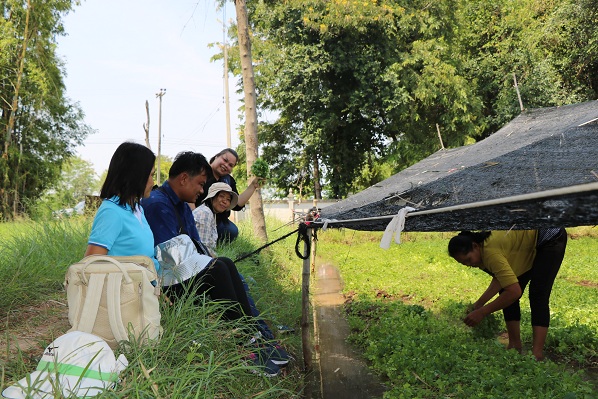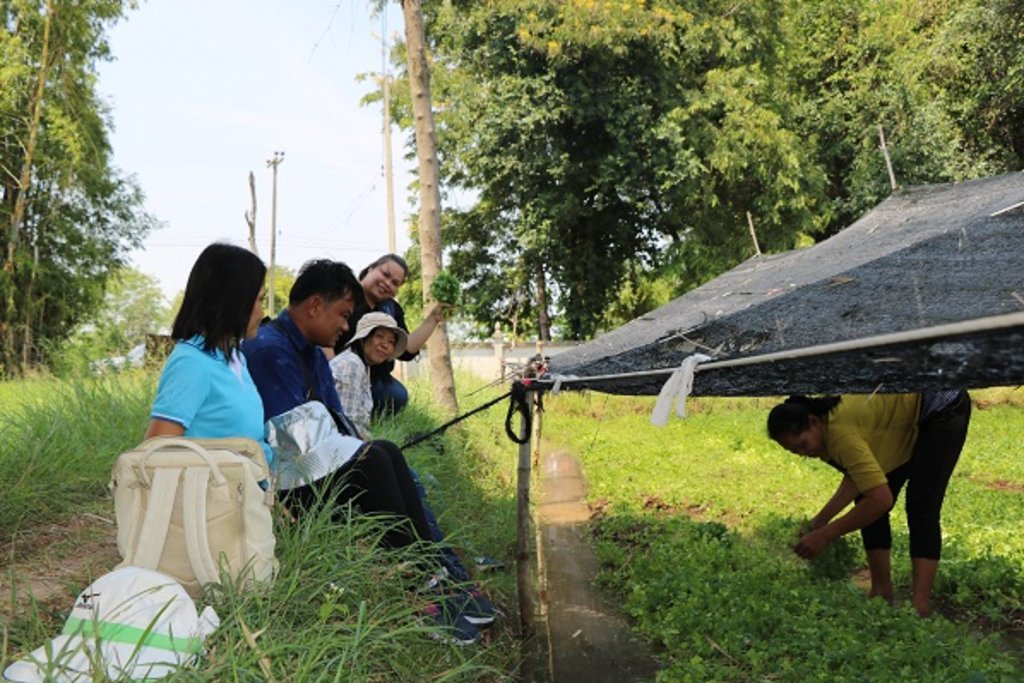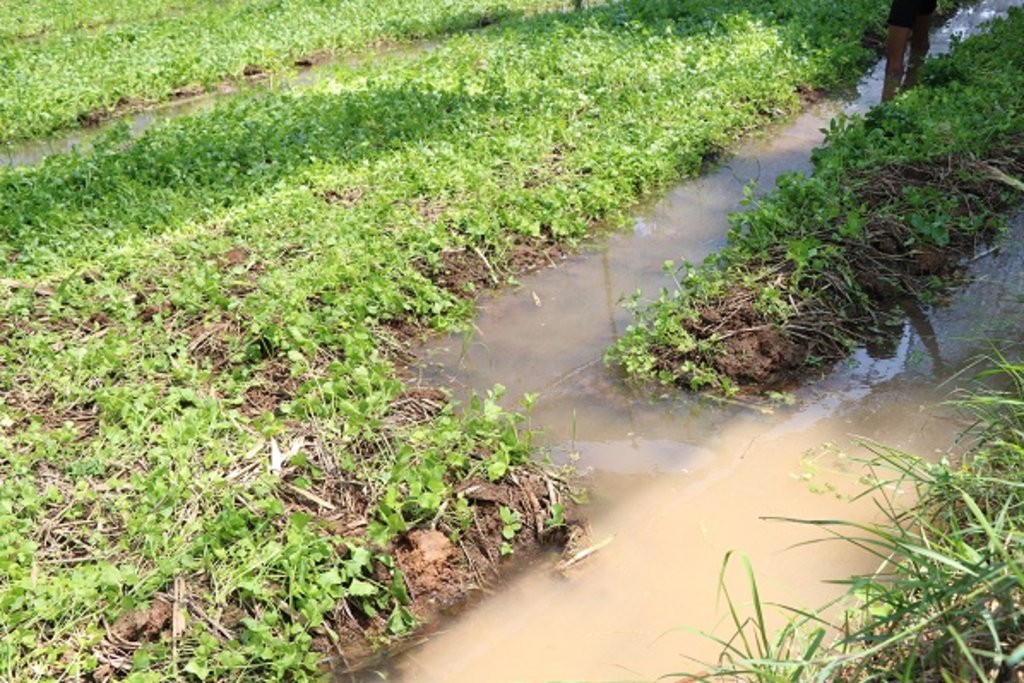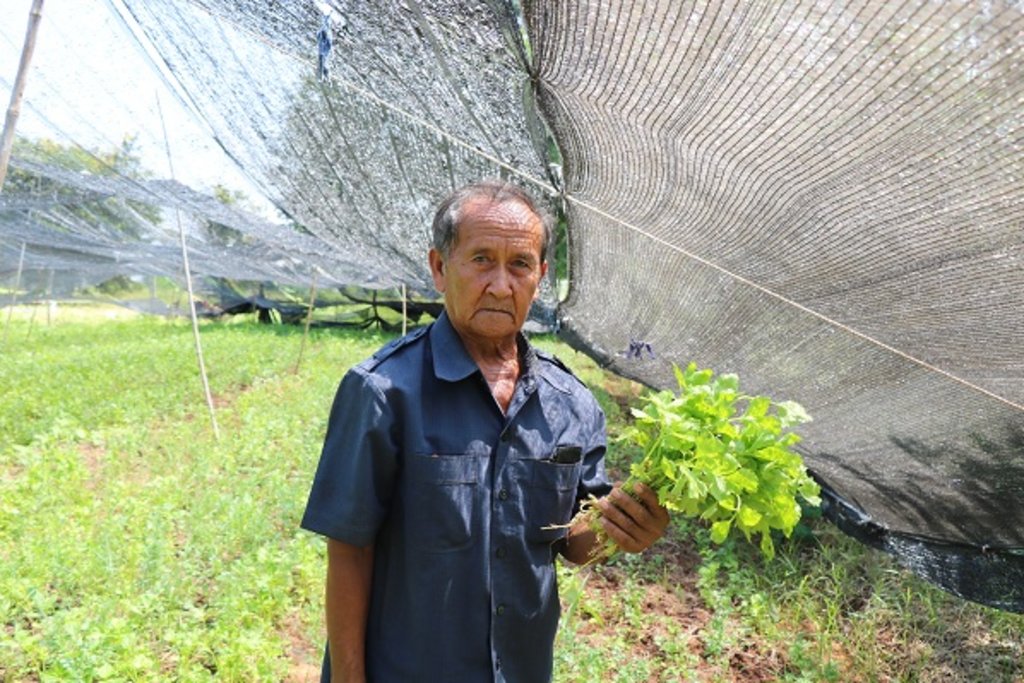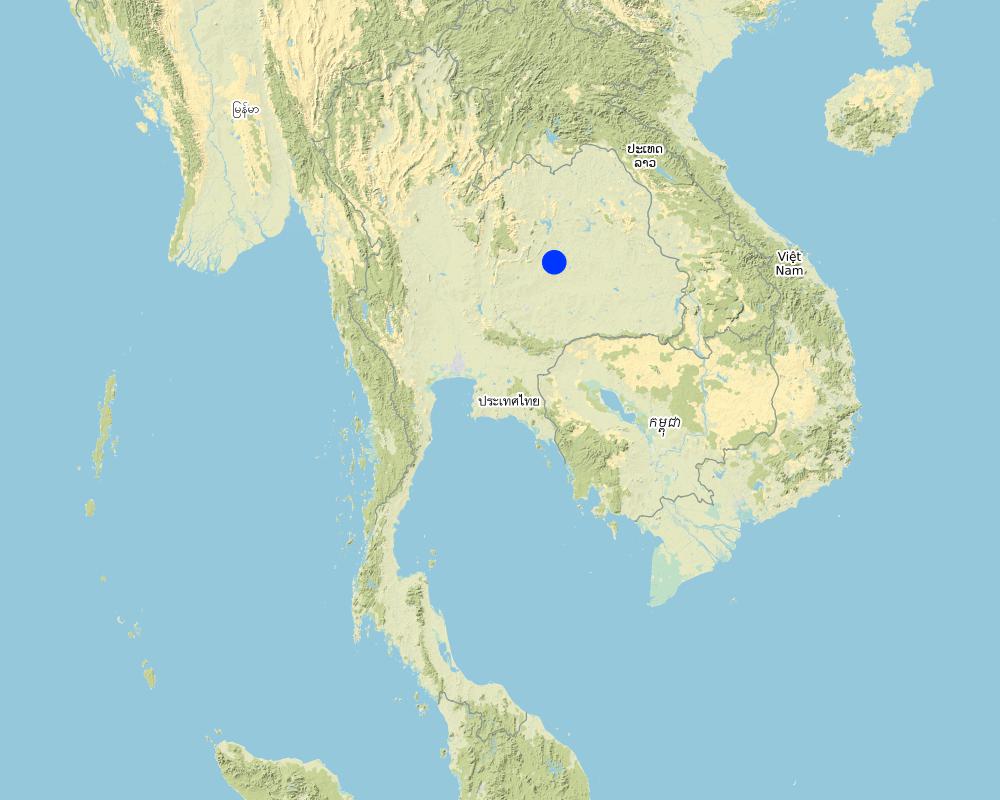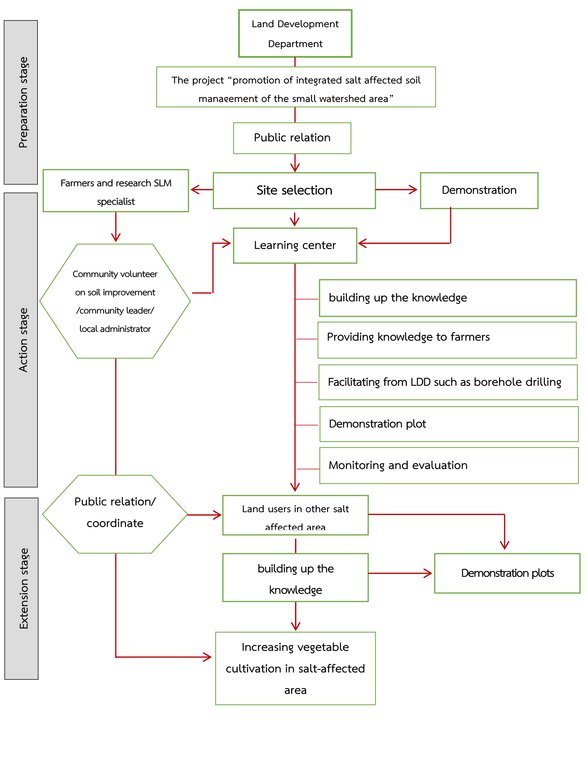Pumping groundwater for vegetable irrigation to prevent salination [Thailand]
- Creation:
- Update:
- Compiler: supranee sritumboon
- Editor: –
- Reviewers: Rima Mekdaschi Studer, Pitayakon Limtong, William Critchley
approaches_4298 - Thailand
View sections
Expand all Collapse all1. General information
1.2 Contact details of resource persons and institutions involved in the assessment and documentation of the Approach
Key resource person(s)
Somked Boonmee
Thailand
SLM specialist:
Sihaban Pranee
pranee782@gmail.com
Land Development Department Regional Office 5
Thailand
SLM specialist:
Sritumboon Supranee
ssritumboon@yahoo.com
Land Development Department Regional Office 5
Thailand
SLM specialist:
Jakkarach Usa
usa_kl@hotmail.com
Land Development Department Regional Office 5
Thailand
SLM specialist:
Rophandung Weera
weerop@hotmail.com
Land Development Department Regional Office 5
Thailand
SLM specialist:
Phothinam Pornpana
laosuwan18@hotmail.com
Land Development Department Regional Office 5
Thailand
SLM specialist:
National Consultant:
Arunin Somsri
ssarunin@gmail.com
Land Development Department
Thailand
Name of project which facilitated the documentation/ evaluation of the Approach (if relevant)
Decision Support for Mainstreaming and Scaling out Sustainable Land Management (GEF-FAO / DS-SLM)Name of project which facilitated the documentation/ evaluation of the Approach (if relevant)
Book project: where people and their land are safer - A Compendium of Good Practices in Disaster Risk Reduction (DRR) (where people and their land are safer)Name of project which facilitated the documentation/ evaluation of the Approach (if relevant)
Book project: where the land is greener - Case Studies and Analysis of Soil and Water Conservation Initiatives Worldwide (where the land is greener)Name of the institution(s) which facilitated the documentation/ evaluation of the Approach (if relevant)
Land Development Department LDD (Land Development Department LDD) - Thailand1.3 Conditions regarding the use of data documented through WOCAT
The compiler and key resource person(s) accept the conditions regarding the use of data documented through WOCAT:
Yes
2. Description of the SLM Approach
2.1 Short description of the Approach
The approach is to develop a simple groundwater pumping model for irrigation, on the basis of cooperation and knowledge sharing between government agencies and farmers, that addresses the risk and prevention of off-site salination.
2.2 Detailed description of the Approach
Detailed description of the Approach:
The objective of groundwater pumping for irrigation is to lower the groundwater level in the recharge zone which in turn decreases soil salinity lower down in the discharge area. The extension and promotion of the approach has been done through the learning and training center. The goal is better understanding and public awareness of preventive measure against salinity, through the use of salt-tolerant crops, combined with mechanical measures of accessing groundwater for irrigation. This has been achieved in close cooperation among researchers, SLM specialists, local administration, and community volunteers on soil improvement. A group of farmers started this activity in 1996 under the Land Development Department (LDD)’s Project on Promotion of Integrated Salt-Affected Soil Management of Small Watershed Areas. The approach aims at scaling-out the model to farmers in the recharge areas with the objectives of sharing benefits that are to (a) persuade other land users to change their land use from rice which is a high water-use crop to low water-use crops such as vegetables, (b) prevent further off-site salination, (c) increase land users’ income, and (d) provide knowledge about integrated salinity management. Researchers and SLM specialists work closely with farmers in monitoring and evaluating the recharge area to prevent extensive salination in the discharge zone - as well as the use of groundwater for irrigation. This plan has been formulated to stimulate further promotion and extension to other areas with a similar environment, through training and public relations. The four stages were: first, the expert and agriculturalist of the LDD’s Regional Office 5 (LDDRO5) cooperated with the volunteer soil doctor and farmers in the community to design and plan the project; second, the officers of LDDRO5 set up a forum for exchange of knowledge and experiences between farmers who have been successful in producing vegetables through using shallow groundwater for agriculture, and are not affected by a salinity. Thirdly, the officers of LDDRO5 collaborated with the government office in the district to train farmers who had an interest in vegetable production. Fourthly, LDDRO5 created incentives for farmers to change areas that are not suitable for planting paddy rice to grow vegetables by supporting shallow groundwater well through pumping with solar energy. The stakeholders include the LDD, SLM specialists and researchers, local administrators, and community volunteers on soil improvement and land users. Land users like the project activities because they receive higher incomes – partially because they do not lose land to digging ponds, but instead irrigate from these deep wells from which they can irrigate all year round. The LDD has supported borehole drilling wells – but farmers are not so happy when they have to wait for over a year to get LDD’s borehole drilling due to budget limitations.
2.3 Photos of the Approach
General remarks regarding photos:
Vegetable cultivation was developed based on farmer experience.
2.4 Videos of the Approach
Date:
02/10/2018
Location:
Ban Kaonoi
Name of videographer:
Supranee Sritumboon
2.5 Country/ region/ locations where the Approach has been applied
Country:
Thailand
Region/ State/ Province:
Khon Kaen
Further specification of location:
Ban Kaonoi
Map
×2.6 Dates of initiation and termination of the Approach
Indicate year of initiation:
2007
If precise year is not known, indicate approximate date when the Approach was initiated:
10-50 years ago
2.7 Type of Approach
- project/ programme based
2.8 Main aims/ objectives of the Approach
The objectives of the approach are to persuade land users in the recharge zone to change their land use to low-water use such as vegetable cultivation, to prevent further off-site salination, to increase land users’ income and provide knowledge of integrated salinity management.
2.9 Conditions enabling or hindering implementation of the Technology/ Technologies applied under the Approach
social/ cultural/ religious norms and values
- enabling
Farmers' community
availability/ access to financial resources and services
- enabling
Farmers get higher income from vegetables.
collaboration/ coordination of actors
- enabling
Researchers, SLM specialists and farmers are working together to implement the project.
knowledge about SLM, access to technical support
- enabling
Provide knowledge of integrated salinity management to farmers.
markets (to purchase inputs, sell products) and prices
- enabling
Farmers can produce plants according to market demand.
3. Participation and roles of stakeholders involved
3.1 Stakeholders involved in the Approach and their roles
- local land users/ local communities
Farmers
Vegetable cultivation
- SLM specialists/ agricultural advisers
Government officers
Support knowledge and technology
- local government
Subdistrict Administration Organization
Support information
- community volunteer on soil
Community volunteers on soil and successful farmers
Share knowledge and experience
If several stakeholders were involved, indicate lead agency:
Land Development Department Regional Office 5
3.2 Involvement of local land users/ local communities in the different phases of the Approach
| Involvement of local land users/ local communities | Specify who was involved and describe activities | |
|---|---|---|
| initiation/ motivation | interactive | Farmers had developed knowledge and technology by themselves |
| planning | self-mobilization | Cultivation planning by farmers |
| implementation | interactive | Farmers had implemented by themselves and were supported by the government |
| monitoring/ evaluation | interactive | The government officers are monitoring and evaluating after the project was implemented |
3.3 Flow chart (if available)
3.4 Decision-making on the selection of SLM Technology/ Technologies
Specify who decided on the selection of the Technology/ Technologies to be implemented:
- land users alone (self-initiative)
Specify on what basis decisions were made:
- personal experience and opinions (undocumented)
4. Technical support, capacity building, and knowledge management
4.1 Capacity building/ training
Was training provided to land users/ other stakeholders?
Yes
Specify who was trained:
- land users
Form of training:
- farmer-to-farmer
Subjects covered:
Promotion of integrated salt-affected soil management of the small watershed area.
Comments:
The topic covered vegetable production and salt-affected soil management.
4.2 Advisory service
Do land users have access to an advisory service?
No
4.3 Institution strengthening (organizational development)
Have institutions been established or strengthened through the Approach?
- yes, greatly
Specify the level(s) at which institutions have been strengthened or established:
- local
Describe institution, roles and responsibilities, members, etc.
The learning and transferring center of land development technology was set up in the community to be used as a training facility, meeting, discussion, and sharing knowledge among farmers and officials.
Specify type of support:
- capacity building/ training
4.4 Monitoring and evaluation
Is monitoring and evaluation part of the Approach?
Yes
Comments:
Government officers, community volunteers on soil improvement and farmers.
If yes, is this documentation intended to be used for monitoring and evaluation?
Yes
4.5 Research
Was research part of the Approach?
No
5. Financing and external material support
5.1 Annual budget for the SLM component of the Approach
If precise annual budget is not known, indicate range:
- 10,000-100,000
5.2 Financial/ material support provided to land users
Did land users receive financial/ material support for implementing the Technology/ Technologies?
No
5.3 Subsidies for specific inputs (including labour)
- equipment
| Specify which inputs were subsidised | To which extent | Specify subsidies |
|---|---|---|
| tools | partly financed | Land Development Department Regional Office 5 supported water pump using solar energy. |
If labour by land users was a substantial input, was it:
- paid in cash
5.4 Credit
Was credit provided under the Approach for SLM activities?
No
5.5 Other incentives or instruments
Were other incentives or instruments used to promote implementation of SLM Technologies?
No
6. Impact analysis and concluding statements
6.1 Impacts of the Approach
Did the Approach empower local land users, improve stakeholder participation?
- No
- Yes, little
- Yes, moderately
- Yes, greatly
Cooperation between the government and farmers.
Did the Approach help land users to implement and maintain SLM Technologies?
- No
- Yes, little
- Yes, moderately
- Yes, greatly
Farmers have a better understanding of the technology and willing to maintain it due to the good result.
Did the Approach improve knowledge and capacities of land users to implement SLM?
- No
- Yes, little
- Yes, moderately
- Yes, greatly
Farmers have adopted the technology to suit their own area.
Did the Approach improve knowledge and capacities of other stakeholders?
- No
- Yes, little
- Yes, moderately
- Yes, greatly
The approach presented the efficient technology to develop salination for the stakeholders.
Did the Approach lead to improved food security/ improved nutrition?
- No
- Yes, little
- Yes, moderately
- Yes, greatly
Different types of vegetables leads to better food security.
Did the Approach improve access to markets?
- No
- Yes, little
- Yes, moderately
- Yes, greatly
Higher productivity draws merchants into the project area.
Did the Approach lead to employment, income opportunities?
- No
- Yes, little
- Yes, moderately
- Yes, greatly
The higher productivity and the wider area used for such technology cause more labour demand resulting in higher employment of people in the area.
6.2 Main motivation of land users to implement SLM
- increased production
Increase variety of product in the area
- reduced land degradation
Decrease salt distribution in soil
6.3 Sustainability of Approach activities
Can the land users sustain what has been implemented through the Approach (without external support)?
- yes
If yes, describe how:
Farmers have a better understanding of off-site salination and they can develop the technology by themselves.
6.4 Strengths/ advantages of the Approach
| Strengths/ advantages/ opportunities in the land user’s view |
|---|
| Farmers get higher income from vegetable cultivation. |
| Land users have water to use for agriculture all year round. |
| Strengths/ advantages/ opportunities in the compiler’s or other key resource person’s view |
|---|
| Increase the varieties of agricultural products. |
| Lower the groundwater level and control the salinity that might spread toward the discharge area. |
6.5 Weaknesses/ disadvantages of the Approach and ways of overcoming them
| Weaknesses/ disadvantages/ risks in the land user’s view | How can they be overcome? |
|---|---|
| Farmers wait for more than one year to get help from LDD for borehole drilling due to limited budget. | Increase more government budget or farmers have to invest by themselves. |
| Weaknesses/ disadvantages/ risks in the compiler’s or other key resource person’s view | How can they be overcome? |
|---|---|
| High initial implementation cost if the farmers do not receive government support. | Farmers have to search for funds to invest by themselves. |
7. References and links
7.1 Methods/ sources of information
- field visits, field surveys
Visit two land user's fields
- interviews with land users
Interview with one farmer
- interviews with SLM specialists/ experts
A Land Development Department officer
7.2 References to available publications
Title, author, year, ISBN:
Land Development Department
Available from where? Costs?
http://www.ldd.go.th/
7.3 Links to relevant information which is available online
Title/ description:
where the land is greener - Case Studies and Analysis of Soil and Water Conservation Initiatives Worldwide
URL:
https://www.wocat.net/library/media/27/
Title/ description:
where people and their land are safer - A Compendium of Good Practices in Disaster Risk Reduction (DRR) (where people and their land are safer) URL:
URL:
https://www.wocat.net/en/projects-and-countries/projects/drr
Links and modules
Expand all Collapse allLinks
No links
Modules
No modules


